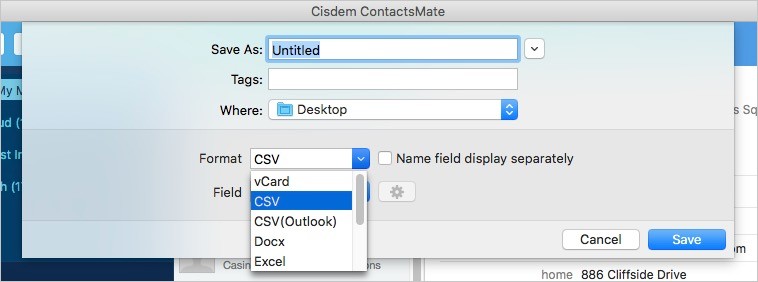“Hi, I use the Outlook email app on my MacBook pro. I am trying to export email contacts as a .csv file but the default download does it as .olm only? How can i download the .csv file?” (From Apple Community)
If you are looking for how to export Outlook contacts to CSV, you are in the right place. This article will show you two practical methods to download the contacts list from Outlook as .csv file.

A CSV (comma-separated values) file is a text file that uses commas to separate values. This format can be used to store contact information. It can be opened by Microsoft Excel, Numbers. As a general file format, it is widely used in business and software programs. It is beneficial to export Outlook contacts to a CSV file.
There are many important contacts in your Outlook account, including leaders, customers, business partners and so on. Their information like phone numbers, emails is saved in Outlook. To prevent contacts data from losing or missing, Outlook users usually export contacts to CSV as a backup, which is an effective way to protect Outlook contacts against loss of data.
If you want to migrate your contacts from Outlook to different email services, like Gmail, Yahoo, Mozilla Thunderbird, Mac OS X Mail, you can import the exported CSV files to these email applications. In most cases, the transition is implemented through CSV files.
The best way to export Outlook contacts to CSV is to use Cisdem ContactsMate, a contacts management tool. It can be used to export Outlook contacts to 9 file formats including CSV (Outlook), CSV, vCard, Excel, Pages, Numbers, Html, Docx, TXT.
Exporting contacts from Outlook to .csv file by this contacts management tool is straightforward and fast, and you only need 5 steps to finish the export process. This method applies to Mac.
Step 1. Download and run the application on your Mac.

Step 2. Click “Add Account” at the top left, select Exchange and sign in.
In the Internet Accounts list, choose Exchange and sign in using your Outlook account.

Step 3. Check the box next to Contacts.
Select the Apps that you want to use with Outlook account, tick the Contacts box and click Done.

Step 4. Click the  button next to the Updated contacts detected message.
button next to the Updated contacts detected message.
Quit and reopen this App, your Outlook contacts are uploaded to this contacts manager.

Step 5. Export contacts to CSV (Outlook) format.
Choose the Outlook Group and right-click Export. In the pop-up window, select “CSV(Outlook)” as the target format, and click Save.

After these five simple steps, your Outlook contacts are exported to a CSV file.
1. Get a unique and special CSV(Outlook) format with Good layout.
The CSV(Outlook) format in Cisdem ContactsMate is specially designed for exporting Outlook contacts. Therefore, the layout of exported CSV(Outlook) file is much better than downloaded by the built-in export feature in Outlook.
Compare the two screenshots:
The first screenshot is a CSV file downloaded via Cisdem ContactsMate with good layout.

The second screenshot is a CSV file downloded by manual method with many blank spaces.

2. Users can define the contacts to be exported.
For the built-in export feature in Outlook, you cannot decide which contacts are downloaded as you need. In contrast, Cisdem ContactsMate allows you to export the contacts you selected, export a group contacts, or export all Outlook contacts. Anyway, it’s up to you.



3. Export a filtered contacts fields.
Usually, the default contacts fields of exported CSV file contain a lot of things: name, address, city, company, title, business phone, home phone, mobile phone, birthday, email, fax and so on.
What if you only need some of them? Cisdem ContactsMate helps you to export as you need. You can decide what kind of contacts information are exported.
> In step 5 above, in Field section, choose Custom Fields, and click the setting icon button.

> Move the contacts fields you need to the right column.

#1. Backup Outlook Contacts with 1 click
One of the reason you export Outlook Contacts to CSV is to backup Outlook Contacts. Actually, Cisdem ContactsMate provides a great place to backup Outlook contacts easily and safely.
Every time you backup the contacts information, it will generate a data version. Every version will be automatically named by the exact time you made the backup. This is the easiest and most convenient way to make sure your contacts are always backed up.
Go straight to the following steps to make a safe backup of Outlook contacts.
1. Launch the program. Click “Cisdem ContactsMate” in the menu and go to “Preferences”.

2. Select “Backup & Restore”, choose “Exchange” in the left side, and Click on “Backup”. Then, all your contacts from Outlook are saved. Similarly, you can backup contacts from Google, iCloud and Facebook.

#2. Transfer Outlook Contacts to other email platforms directly
Some people export Outlook contacts to CSV because they want to transfer Outlook contacts to Gmail or different email services.
In fact, Cisdem ContactsMate provides a direct way to migrate Outlook Contacts to Gmail or other email platforms quickly. You don’t need to export Outlook contacts to CSV, and then import CSV to other email accounts.
1. Click “Add Account” at the top left to add a different email platform. Here I take Gmail as an example.
2. Select Google and sign in using your Gmail account. And check the box next to Contacts.

3. Quit and relaunch the application. Your Gmail contacts are uploaded to this contacts manager.
4. Select the contacts from Google Group or select All, move them to Exchange Group with a drag and drop.

#3. Remove duplicate contacts intelligently and quickly
When you try to migrate Outlook contacts to other email platforms, duplicate contacts might be generated. It is easy to remove and merge duplicate contacts with the help of Cisdem ContactsMate.
1. Launch the program and click Scan in the top menu.

2. After several seconds, the scanning result will be listed. Select Duplicate name or Exact duplicate contacts, click “Delete duplicate contacts” or “Ignore” under the solution, and click Fix All.

This feature is really amazing. You can fix duplicate contacts very quickly.
Comparing with using a contacts tool, exporting Outlook contacts to CSV manually is complicated. To save your time, we collect some key points that you need to know at first.
1. Different versions of Outlook need different steps.
For different Outlook versions, the steps used to export Outlook contacts to CSV are different. So, it is very important for you to figure out what version of Outlook you are using.
In this article, the steps to copy Outlook contacts to CSV for the Outlook versions below are introduced:
If you make a mistake on your Outlook version, you will not export Outlook contacts to CSV successfully.
2. By taking manual steps, you won’t get a nicely-formatted CSV file as you expected.
Exporting Outlook contacts to CSV manually is not an easy thing. One of the biggest disadvantage is that, the exported CSV file is totally a big mess.
There are a lot of empty cells. Every line has dozens of items and you have to move your mouse to right to see the whole data. It takes you hours to adjust the CSV file.

3. You may export incomplete data by manual method.
Some users who manually export Outlook contacts to CSV said that the exported data is incomplete. In the exported CSV file, some information is missing. I must remind you that the built-in export feature in Outlook is not powerful. Remember to check if the information exported is complete.
4. Repeating the export process leads to duplicate contacts.
The reason why most of people export Outlook contacts to CSV is that they want to upload contacts to other programs, like Gmail, Yahoo.
As long as new contacts are added to your Outlook account, you may repeat the export process all the time to migrate the new contacts to your preferred email platforms.
By doing so, duplicate contacts are definitely generated. Duplicate contacts are always annoying and intolerable, especially for these who want to keep their contacts organized.
1. Open Outlook 2010. Go to File menu.

2. Go to options.

3. In the new window, click Advanced tab.

4. Under the Export section, click Export.

5. In “Import and Export Wizard”, select “Export to a file” option, and click Next.

6. Choose Comma Separated Values (Windows) in the list and then click Next.

7. Select a folder that you plan to export from. To export all contacts, just click on “Contacts”, and then click Next.

8. Click Browse and find a destination folder to store the CSV file. Type a name for the file. Then click OK.

9. In the Export to a File window, click Next.
10. Click Finish to start the exporting process. Then, the CSV file will be downloaded to your destination folder on your computer.

1. In Outlook 2013, Outlook 2016, Outlook 2019, click the File tab.

2. Select Open & Export and go to Import/Export.

3. In Import and Export Wizard, select Export to a file and click Next.

4. Choose Comma Separated Values as target format, and click Next.

5. Select Contacts option and click Next.

6. Name the file and click OK.

7. Click Browse to find a location on your computer to save the file.

8. Check the box to confirm your operation, and click Finish to start the exporting process.

1. Go to Outlook.com
2. Sign in to access your Outlook.
3. Click the application icon at the top left corner.

4. Select People in the menu list.

5. Select the contacts you need one by one or directly select All contacts.

6. Click Manage in the right corner of the page. And go to Export contacts option.

7. In the pop-up window, click Export to make sure you are going to export contacts from Outlook.

Comparing with downloading CSV file manually, it is more efficient to use Cisdem ContactsMate to export Outlook contacts to .csv file. The export process can be finished with only 5 easy steps. The CSV(Outlook) export format is unique. What’s more, it has many awesome and fantastic features, including backup contacts with 1 click, directly migrate Outlook contacts to other Apps.

With a passion for tech and writing, Sarah joined Cisdem, where she focuses on creating articles about using utility tools to enhance file management and simplify contact management.

